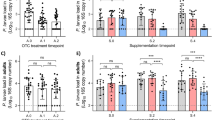Abstract
Beewolf digger wasps cultivate specific symbiotic bacteria (Streptomyces spp.) that are incorporated into the larval cocoon for protection against pathogens. We identified the molecular basis of this protective symbiosis in the natural context and demonstrate that the bacteria produce a 'cocktail' of nine antibiotic substances. The complementary action of all symbiont-produced antibiotics confers a potent antimicrobial defense for the wasp larvae that parallels the 'combination prophylaxis' known from human medicine.


Similar content being viewed by others
References
Dubilier, N., Bergin, C. & Lott, C. Nat. Rev. Microbiol. 6, 725–740 (2008).
Currie, C.R., Scott, J.A., Summerbell, R.C. & Malloch, D. Nature 398, 701–704 (1999).
Bourtzis, K. & Miller, T.A. Insect Symbiosis (CRC Press, Boca Raton, Florida, USA, 2006).
Haeder, S., Wirth, R., Herz, H. & Spiteller, D. Proc. Natl. Acad. Sci. USA 106, 4742–4746 (2009).
Scott, J.J. et al. Science 322, 63 (2008).
Kaltenpoth, M. et al. Int. J. Syst. Evol. Microbiol. 56, 1403–1411 (2006).
Kaltenpoth, M., Goettler, W., Herzner, G. & Strohm, E. Curr. Biol. 15, 475–479 (2005).
Strohm, E. & Linsenmair, K.E. Ecol. Entomol. 26, 198–203 (2001).
Herzner, G. & Strohm, E. Curr. Biol. 17, R46–R47 (2007).
Strohm, E. & Linsenmair, K.E. Zoology 98, 137–146 (1995).
Goettler, W., Kaltenpoth, M., Herzner, G. & Strohm, E. Arthropod Struct. Dev. 36, 1–9 (2007).
Behal, V. Adv. Appl. Microbiol. 47, 113–156 (2000).
Kieser, T., Bibb, M.J., Buttner, M.J., Chater, K.F. & Hopwood, D.A. Practical Streptomyces Genetics (John Innes Foundation, Norwich, UK, 2000).
Shin, H.J. et al. J. Microbiol. Biotechnol. 17, 1403–1406 (2007).
Tamura, S. et al. Agric. Biol. Chem. 27, 576–582 (1963).
Takahashi, N. et al. Agric. Biol. Chem. 32, 1115–1122 (1968).
Matsumoto, M. et al. J. Antibiot. 40, 149–156 (1987).
Hoelscher, D. et al. Plant J. 60, 907–918 (2009).
Oh, D.C., Poulsen, M., Currie, C.R. & Clardy, J. Nat. Chem. Biol. 5, 391–393 (2009).
Yim, G., Wang, H.M.H. & Davies, J. Philos Trans. R. Soc. Lond. B Biol. Sci. 362, 1195–1200 (2007).
Clardy, J., Fischbach, M.A. & Currie, C.R. Curr. Biol. 19, R437–R441 (2009).
Ugelvig, L.V. & Cremer, S. Curr. Biol. 17, 1967–1971 (2007).
Hughes, D.P., Pierce, N.E. & Boomsma, J.J. Trends Ecol. Evol. 23, 672–677 (2008).
Winston, L.G. & Chambers, H.F. in Hospital Medicine 2nd edn. (eds. Wachter, R.M., Goldman, L. & Hollander, H.) 623–632 (Lippincott, Williams & Wilkins, Philadelphia, 2005).
Kaltenpoth, M. Trends Microbiol. 17, 529–535 (2009).
Acknowledgements
We acknowledge financial support from the Max Planck Society (J.K., B.S., R.K.M. and A.S.), the German Research Foundation Deutsche Forschungsgemeinschaft (J.K., M.K. and E.S.), the Volkswagen Foundation (M.K.), the International Leibniz Research School for Microbial and Biomolecular Interactions (M.-G.S. and C.H.) and the Jena School for Microbial Communication (M.-G.S. and C.H.). We thank K. Roeser-Mueller, T. Engl and K. Angermeier (all at the University of Regensburg) for providing beewolf cocoons; J. Doubský (Max Planck Institute for Chemical Ecology) for the camalexin standard; and J. Seger for valuable comments on the manuscript.
Author information
Authors and Affiliations
Contributions
J.K., A.S. and M.K. conceived of the study. J.K. and A.S. isolated, identified and quantified the antibiotic substances and performed the imaging mass spectrometry. J.K., A.S., M.K. and E.S. wrote the manuscript. B.S. carried out the NMR experiments. M.-G.S. and C.H. performed the biological activity experiments. R.K.M. conducted the MS-MS experiments. M.K. and E.S. carried out the GC-MS experiments.
Corresponding authors
Ethics declarations
Competing interests
The authors declare no competing financial interests.
Supplementary information
Supplementary Text and Figures
Supplementary Methods and Supplementary Results (PDF 837 kb)
Rights and permissions
About this article
Cite this article
Kroiss, J., Kaltenpoth, M., Schneider, B. et al. Symbiotic streptomycetes provide antibiotic combination prophylaxis for wasp offspring. Nat Chem Biol 6, 261–263 (2010). https://doi.org/10.1038/nchembio.331
Received:
Accepted:
Published:
Issue Date:
DOI: https://doi.org/10.1038/nchembio.331
- Springer Nature America, Inc.
This article is cited by
-
The gut microbiota of insects: a potential source of bacteria and metabolites
International Journal of Tropical Insect Science (2024)
-
Impact of intraspecific variation in insect microbiomes on host phenotype and evolution
The ISME Journal (2023)
-
Bacteria, yeasts, and fungi associated with larval food of Brazilian native stingless bees
Scientific Reports (2023)
-
Proposal of Streptomyces sporoverrucosus Gause et al. 1983 as a later heterotypic synonym of Streptomyces goshikiensis Niida et al. 1966 and an emended description of Streptomyces goshikiensis
Antonie van Leeuwenhoek (2023)
-
Diversity and antimicrobial activities of culturable actinomycetes from Odontotermes formosanus (Blattaria: Termitidae)
BMC Microbiology (2022)




